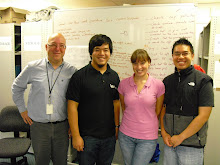Now, I guess I should introduce myself. My name is Chee Kit Wong, or more commonly known as Kit. I am a research scientist within the Engineering Innovation team at Industrial Research Limited (IRL) in Auckland. IRL is a crown research institute with a focus on research and development in science and engineering.
As Katharine has already explained, we are a research collaboration that is funded by Creative New Zealand through the Smash Palace Fund. The objective of this funding is to foster linkages between artists and scientists. Essentially, the team consists of three main members: Katharine Ngatai aka KatyPie, Dr Emilio Calius and myself! In addition, we are also supported by Mr Tokushu Inamura. We have very different backgrounds and interests; and therefore play very different roles within the team.
Katharine, being the artist, is our creative brain. If you haven't seen her work, you should. She has some amazing pieces! Emilio is an expert in smart materials and is a colleague of mine at IRL.
As for me, my interest is in the application of spatial reasoning for the development of intelligent robotic systems. Particularly, I am interested in how humans and animals do not acquire precise representations of their surroundings but yet, still able to navigate successfully. This is very different from traditional robotics research in navigation and mapping, where every environment must be represented precisely. If you are interested to find out more, visit: http://aut.researchgateway.ac.nz/handle/10292/427
I see my involvement in this project as being twofold. Firstly, to address the electronics requirements of the project; and secondly, developing the software to control and provide life-like interactions with the viewing public. I envisage that I will utilise a lot of my prior experience in information extraction and interpretation from sensing devices; and at the same time, develop new knowledge in human machine interactions.
Prior to this project, I have not had any experience with Dielectric Elastomers. To be honest, the whole smart material domain was very foreign to me. I really did not know what to expect! One of the first things we did was to visit the Biomimetics Laboratory at Auckland University. We were given a quick tour and were shown some of the pieces that were created by the students at the lab. I have to admit, I was astonished. I have not come across actuators that are so life-like. More importantly, the pieces are very compact, mainly because the pieces are themselves the actuators! Instantly, Katharine and I saw why Emilio was so interested in applying this material for art.
Dielectric Elastromer Actuators (DEA) are very different from traditional actuators. One important difference is the fact that DEA actuates itself, whilst motors and other traditional actuators are used as means to provide actuation. Traditional actuators are clunky and often, and consequently, the size of any design is restricted by the size of the actuator. For DEAs though, one can construct as big, or as small an actuator as one desires, at least in theory. And because the material is of non-rigid characteristics, its looks and movement is extremely life-like, as one can see from the video images in Katharine’s blogs.
However, it is not easy to work with the DE materials. A lot of the processes are very manual and hence, very time-consuming. At times, this can be quite frustrating as it takes so long to make a single piece. In some instances, we have to develop the process ourselves! However, we learn something new all the time and that is very rewarding.
Thats all from me, for now. My next blog will be on latex. Yup ;-)







